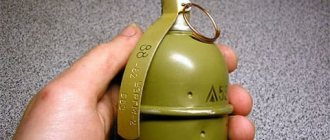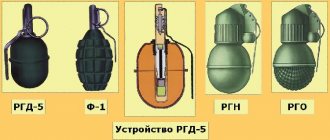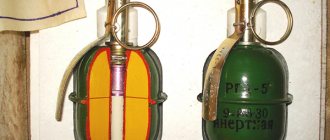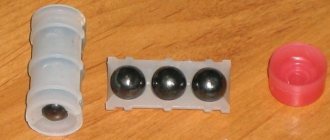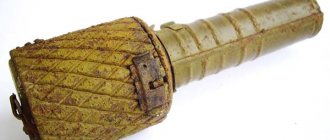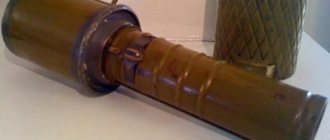RGD-33 hand grenade, Dyakonov system, model 1933.
They have been used on all fronts and are found everywhere. When using a defensive cover (shirt) the grenade is defensive, without a shirt it is offensive. They were produced by various factories, workshops, etc. These specimens could have deviations in shape and size. During the defense of Sevastopol, grenades were produced in the city, on top of which instead of a tape with fragmentation threads, steel wire was wound over the charge.
Weight without shirt - 500 g; with a shirt - 750 g; charge - 125 g; Moderator burning time is 3.5-4.5 seconds. Dangerous distance: with a protective cover - 100 m; without a defensive cover - 25 m. They were equipped with cast and pressed TNT, during the Second World War they were equipped with various surrogates. If the handle is pulled back, the grenade is cocked.
RGD-33 is perhaps the most common Soviet grenade during the war. Many search engines have had to deal with it in their work. RGD-33 can be found in the most unexpected places. Half-rotten, with fallen off handles and decomposed TNT along with the remains of soldiers, laid out in a row, platooned on the parapets of trenches, already abandoned, but for some reason not exploded, defended in battle and stored in dugouts. The abundance of these fans often dulls vigilance, and RGD-33 is dangerous, like any other explosive object.
RGO grenade
RGO (defensive hand grenade) - hand-held anti-personnel DEFENSIVE shock-remote.
Designed to defeat manpower in defensive combat.
The radius of destruction by grenade fragments is 50 meters, the radius of possible damage is 100 meters. In terms of performance characteristics, it is generally similar to the F-1 grenade, but unlike it, it has a combined impact-remote fuse.
Tactical and technical characteristics of the Russian Geographical Society
Type of grenade - hand-held anti-personnel fragmentation defensive shock-remote
Characteristics:
Weight: 530 g; Throwing range: 30 m; Ignition time: 3-4 seconds; Number of fragments: 700 pcs.; Self-destruction time: 3.2-4.2 seconds; Long cocking time: 1.3-1.8 sec.; The method of delivery to the target is only hand throw; The method of delivery to the target is “trip”, “trap”.
Application of RGO
A grenade is delivered to the target only by throwing it with the soldier’s hand.
A grenade explodes when the grenade hits a surface. The fuse is ubiquitous, that is, it does not matter which part of the grenade hit the surface, and the position of the surface (vertical, horizontal, inclined) does not matter. The only thing that matters is the deceleration speed of the grenade when it hits the surface. If it hits the surface of water or loose, freshly fallen snow, the fuse may not work.
In order to increase the safety of the grenade launcher and ensure that the grenade does not explode if it accidentally encounters an obstacle at a close distance from the grenade launcher, the fuse is cocked only after 1.3-1.8 seconds. after the safety lever is released (the grenade is thrown). That is, if the grenade hits something at this time, the explosion will not occur at all.
If the grenade explosion did not occur from the impact fuse (the grenade was not thrown, but the lever was released; the grenade is still in flight; the grenade fell into water or loose snow), then after 3.2-4.2 seconds after the safety lever is released, an self-destruction of a grenade by detonation. In this regard, the grenade works exactly the same as the F-1, RG-42, RGD-5 grenades.
Simply put, the effect of a grenade is exactly the same as that of old grenades, but if in the period of time from the moment of throwing between 1.3-1.8 - 3.2-4.2 seconds. the grenade hits something, then an explosion will occur from the impact. A combat grenade is painted an olive-grayish color; The training simulation grenade is painted black.
Download:
Hand grenades - Instruction (1971).djvu665 KB
F-1 hand grenade (defensive)
The most widely known. Its structure is studied even at school. Invented at the beginning of the century by the designer Lemon, this is probably why it received the unofficial name “limon”, and not at all because of its lemon-shaped, ovoid shape. The F-1 grenade is still in service in many countries around the world, but with fuses of different designs. During the war, from beginning to end, it was in service with the Red Army, Finnish and Polish armies. The Germans did not have such a grenade in their arsenal; they used captured ones.
The grenade is defensive, the radius of scattering of the largest fragments is up to 200 m. It is thrown from trenches and shelters. The body of the grenade is cast iron, its surface is cut with transverse and longitudinal grooves to improve crushing. The weight of a loaded grenade is 600-750 g. This variation in weight data is explained by the different shapes and sizes of grenade bodies. The combat charge has a constant weight of 50 g - flake, cast or pressed TNT into the body. The use of a more powerful explosive would have resulted in the cast iron body of the grenade turning into dust rather than into fragments upon explosion. Length - 124 mm; diameter - 65 mm; Ignition retarder burning time: Koveshnikov - 3.5-4.5 seconds; UZRG - 3.2-4.2 seconds.
In pre-war times and in the initial period of the war, the grenade was equipped with a fuse of the Koveshnikov system, which was later replaced by a simpler and more technologically advanced UZRG fuse.
First of all, you should pay attention to the presence and condition of the safety pin. Military-issue grenades were sometimes equipped with surrogate explosives, which sometimes had unpredictable properties. Near Leningrad there are grenades filled with black powder.
Often, search engines in the north-west find so-called “blockade grenades” - substandard 50 mm mortar shells were used as casings. In terms of combat properties - charge weight, lethal radius, they correspond to the F-1.
Shattering fragments: modern domestic hand grenades
A new remote-action hand-held fragmentation grenade appeared in service with the Soviet Army only nine years after the war. It was an offensive RGD-5 with an UZRGM fuse (UZRGM-2), which was put into service in 1954. The RG-42 and F-1 grenades with the same fuse continued to remain in service without any changes.
However, grenades with remote fuses are not suitable for hitting moving targets, vehicles, quickly moving manpower, etc. When thrown, for example, along window openings on the upper floors or in mountainous areas from bottom to top, if it misses, the grenade may bounce or roll back. There is an obvious need to correct this situation.
TAKEN INTO ACCUSED EXPERIENCE
| Rice. 1 and 2 Hand fragmentation grenades: offensive RGN (left) and defensive RGO (right) |
In 1982, two completely new types of grenades were put into service - the offensive RGN and the defensive RGO. They differed from their predecessors in the design of both the housings and the fuses. They had a single latter, developed taking into account the experience of the combat use of hand grenades and new technological capabilities that made it possible to minimize the cost of their production. The development was carried out by two enterprises - SNPP "Basalt" was engaged in the bodies and equipment of grenades, and a specialized enterprise near Moscow created for them a single UDS fuse, the main elements of which were made of injection molded plastics using a high-performance method. The author of the project is V. Kuzmin, led and completed the development by V. Yakunin. The leading performer of the ignition work was D. Denisov.
The body designs of both grenades were developed on the basis of long-term research work, as a result of which methods were found to increase the density of the fragmentation flow within the specified damage radii. To do this, it was necessary to achieve organized crushing of the hull into fragments of more or less equal mass. For an offensive grenade, they must lose their lethal effect at a distance of no more than 10 m in order to guarantee the safety of the soldier throwing it while moving. In this regard, our RG-42 is far from ideal. Its fragments (albeit at the end) fly up to 20 m from the explosion site, not to mention the fuse parts that were found at ranges of more than 100 m. Throwing such a grenade while running, you can find yourself in the danger zone by the time it explodes. Worthy of criticism and, perhaps, the best in its class is our F-1 defensive grenade. Its body, cast from steel cast iron, has corrugations on the outside, dividing the body into 32 parts, but the grenade is not torn along them. When ruptured, its body produces several hundred fragments, the largest of which retain lethality up to 200 m. This grenade can only be thrown from behind cover. But the probability of hitting growth targets at a distance of 15-20 m from the explosion site due to an insufficiently dense flow of its fragments still leaves much to be desired.
All these circumstances were taken into account by the creators of the RGN and RGO grenades. The result of their work was new hand fragmentation grenades, which found widespread use during combat operations in Afghanistan and the North Caucasus.
IMPACT-REMOTE FUZE – UDZ
| Rice. 3 Device of shock-remote fuse UDZ |
The fuse has a unique and interesting design. His work is shown in Fig. 4. The drawings were compiled by the author based on mock-up samples of fuses kindly provided to him by the State Research and Production Enterprise “Basalt”; Photographs of grenades were also taken there.
The fuse consists of four main units (Fig. 3): - an initiating one, including a firing pin 2 with a pin-type mainspring, a safety lever 4 and a pin with a ring 3, which holds the firing pin in the cocked position through the safety lever. This unit activates the pyrotechnic chains for arming and self-destruction of the fuse; - pyrotechnic, which includes an impact igniter capsule 5, a long-range cocking device in the form of two duplicating pyrotechnic moderators 6 and a self-liquidator 8. Pyrotechnic devices (moderators and self-liquidator) are three tubes made of aluminum alloy with threads for screwing them into a plastic the body is fuse. Stably burning and low-hygroscopic low-gas compositions are pressed into the tubes, specially designed for self-liquidators and moderators of various fuses; - mechanical, the elements of which are an inertial load 1 (a plastic ball with steel balls filled inside), a cup 12 with a needle and a safety engine 10 with an intermediate captive capsule 9. The engine is under the action of a pin-type spring, pressing it against the retarder rod 7. B In this position of the engine, the intermediate capsule is located away from the detonator igniter, and the end of the cup with the needle, resting on the plane of the engine, cannot move in the direction of the detonator. To ensure that the engine with the capsule is kept in a secured position, a second similar retarder is introduced into the mechanism; — detonator 11 with a beam-type igniter.
To use a grenade, you need to take it in your hand, press the safety lever to the body with your fingers, straighten the antennae of the pin and, pulling it out, throw the grenade.
At the initial stage of the flight, the firing pin, turning under the action of the mainspring, throws off the safety lever. The intermediate position of the striker is shown in Fig. 4, view B. At the end of the rotation of the striker, its needle pierces the igniter capsule, which, when triggered, activates three pyrotechnic units: two duplicating moderators and a self-liquidator (Fig. 4, views B and D). The spread in the burning time of retardation tubes under different temperature conditions is 0.8–1.1 s.
After the compositions of these tubes burn out, the springs remove the rods 7 inside the tubes, and the released engine is moved by its spring until it stops against the housing wall (Fig. 4, view E). In this position of the engine, the cup with the needle no longer rests on its plane and can move towards the igniter primer. But this does not happen before meeting an obstacle, since the cup with the load is held by a spring.
| Rice. 4 Work fuse UDS |
When a grenade meets an obstacle, the force of inertia shifts the load to the side and displaces the cup with the needle in the direction of the igniter capsule. The flame of the triggered igniter primer initiates the explosion of the detonator and the rupture of the grenade (Fig. 4, view E).
If, due to a weak puncture of the igniter primer, it does not work (for example, when a grenade falls into the snow), then its rupture will occur after the composition of the self-liquidator burns out. Under different temperature conditions, this time can be from 3 to 4.3 s.
Rice.
5 RGN grenade in cross-section HAND OFFENSIVE GRENADE RGN
The grenade body consists of two thick-walled and smooth outside stamped hemispheres made of aluminum alloy (Fig. 5). The hemispheres have deep grooves inside for organized crushing of the body. Their edges are turned so that it is possible to put the upper hemisphere on the lower hemisphere and connect them by crimping “along the equator”. A sealing polyethylene ring is first placed between them. In the hole of the upper hemisphere there is a thin-walled cup with several turns of M20x2 thread in the upper part for screwing in the fuse.
To equip the RGN, a more powerful explosive was used than for previous grenades - hexogen with the addition of TNT. Crystalline hexogen itself does not melt, but its mixture with TNT can be melted and poured into the grenade body. There are mixtures with different percentages of hexogen and TNT. For example, in TGA there are 50/50. After filling the explosive, a socket for the fuse detonator is drilled into it. The design of the grenade body allows it to be equipped with pressed bombs of an even more powerful explosive, for example A-IX-1, which is a phlegmatized hexogen,
An RGN grenade with an UDZ fuse weighs 310 g. Its explosive weight is 112 g.
Testing the fragmentation effect of grenades using the established method shows an approximately threefold advantage of the RGN over the RG-42.
| Main characteristics of hand grenades | ||
| Characteristic | RGN | RGS |
| Grenade type | Offensive | Defensive |
| Weight in firing position, g | 310 | 530 |
| Explosive mass, g | 112 | 90 |
| Fuse | UDS | UDS |
| Action type | percussive or slow | percussive or slow |
| Deceleration time, s | 3…4,3 | 3…4,3 |
Rice.
6 RGO grenade cross-section HAND DEFENSE GRENADE RGO
The body of this grenade also consists of two hemispheres, but they are not stamped from aluminum alloy, but from thick sheet steel and have deep corrugations on the inner surface (Fig. 6). The lower hemisphere has corrugations on the outside, while the upper hemisphere is smooth on the outside. This was done so that the type of grenade could be determined by touch. To increase the number of fragments, another one was inserted inside these hemispheres, but with only internal corrugations. The joint of the outer hemispheres, like that of the RGN grenade, is sealed with an annular polyethylene gasket. The outside of the body is painted with standard green paint.
In combat position, the RGO has a weight of 530 g, with an explosive weight (TNT with hexogen) of 90 g. The dispersion range of its lethal fragments is significantly less than that of the F-1. According to the "Guide" for this grenade, it is 16 m, but it can still only be thrown from behind cover. Within this range, the fragmentation field density of the RGO is at least three times higher than that of the F-1.
Excerpt from an article by D. Shiryaev photos by Olga Khvostunova drawings by the author World of Weapons 4-2005
Hand fragmentation offensive grenade RG-42 model 1942
Offensive, remote action. It was developed and put into service in 1942. It was in service with the Soviet Army until the 80s. Extremely simple in design and technologically advanced. Any workshop with stamping equipment and spot welding could master its production. They were used on all fronts of the Second World War.
The radius of scattering of fragments is up to 100 m. The weight of the grenade is 400-420 g.
Fuses of the Koveshnikov and UZRG systems were used. The ignition socket of each grenade was closed with a threaded plastic plug or steel cap. Fuses were screwed into grenades only during preparation for battle.
Externally, the grenade resembles a tin can. An explosive charge and a metal steel tape, cut into squares, rolled into 3-4 turns (as in RGD-33), were placed inside the case to increase the number of fragments. The explosive charge is cast or pressed TNT.
Technical means of throwing
Technical means for throwing grenades have been used for a long time. Starting with the use of muzzle-loading mortars for throwing grenades, and later devices.
Thus, Russian officer M.G. In 1916, Dyakonov proposed a variant of a device for throwing grenades screwed onto the barrel of a Mosin rifle. In 1917, the invention was put into service, but was soon discontinued due to the demobilization of the army.
But the designer continued development and 10 years later, in 1928, the Dyakonov grenade launcher and rifle (or rifle) grenade entered service with the Red Army.
Now grenade launchers have become a type of weapon that is easy to use by infantry units.
Armies around the world use anti-tank grenade launchers and their under-barrel versions attached to small arms.
Trends in design are associated with reducing the weight of weapons, increasing combat qualities and diversity in use. But the hand grenade still remains the faithful combat friend of the infantryman.
Anti-tank hand grenade RPG-40 model 1940
Intended to combat light and medium tanks with armor up to 20 mm and other targets. Serial production began only with the beginning of the war.
The weight of the RPG is 40 - 1200 g, the weight of the explosive charge is 760 g. The grenade consists of a tin body in which the explosive charge is placed - cast or pressed TNT, on top there is a cover like the RGD-33, under which a fuse was inserted, which in appearance is also very similar to the fuse RGD-33, but instant action. During loading, the housing was screwed onto the handle, which housed the impact and safety mechanisms.
The fuse ignites and the grenade explodes instantly when the grenade hits an obstacle. The grenade was thrown from behind cover, since the radius of its destructive effect is 20 m, and throwing it over a greater distance is problematic.
When hitting an obstacle, the grenade mechanism is triggered, regardless of where the grenade hits, and the grenade explodes. The trigger force is very small; you just need to drop the grenade on the ground.
In a combat situation, it was allowed to equip grenades with fuses only immediately before throwing. Failures in operation occurred due to contamination, freezing and deformation of the impact mechanism located in the handle. Failures may result from a faulty igniter.
The RPG-40 is found in all areas of combat operations, especially in the initial period of the war. Found during a search is a dangerous find.
RGN grenade
RGN - OFFENSIVE hand grenade, anti-personnel fragmentation impact grenade. Designed to defeat manpower in battle.
Characteristics of RGN
Weight, kg: 290 g; Length, mm: 113 mm; Diameter, mm: 60 mm; Explosive: A-IX-1 (96% RDX, 4% wax) (plastic); Mass of explosive, kg: 97 g; Detonation mechanism: Ignition of the ULDS with a deceleration time of 3.2-4.2 s.
The radius of damage from grenade fragments is 15 meters, the radius of possible damage is 35 meters.
Application of RGN
The RGN fuse is cocked only 1.3-1.8 seconds after the safety lever is released. If during this time the fuse experiences a noticeable shock, it is dearmed and the grenade does not explode; this protects against accidents if a grenade is accidentally dropped nearby. Material from the Unfair Advantage community. Next, the fuse goes into a state in which the grenade explodes upon impact with the target. If the grenade explosion did not occur from an impact fuse (for example, when it hits deep snow or grass), then the grenade explosion occurs 3.2-4.2 seconds after the release of the clamping lever. Before throwing, you must first remove the safety ring by pressing the lever with your fingers to the body of the grenade. The combat grenade is painted an olive-grayish color.
Anti-tank hand grenade RPG-41 model 1941
Calling this anti-tank grenade can only be a bit of a stretch, since all anti-tank grenades are instant action, and the RPG-41 is an RGD-33 enlarged in size, and from the RGD-33 they used a handle with a primer pinning mechanism and a fuse, and a bolt on the body the fuse, its tube, extended by 50 mm, and the lower part of the body into which the handle (flange) was screwed. The grenade was developed and used during the initial period of the war and was manufactured only at that time. The RPG-41 owed its appearance to Klement Efremovich Voroshilov, the commander-in-chief of the North-Western direction, on whose initiative and on Stalin’s personal instructions these ridiculous, inconvenient grenades with the unofficial name “Voroshilovsky kilogram” (“VK”) were manufactured. As soon as Zhukov replaced Voroshilov as commander of the Lenfront, production of the RPG-41 was discontinued. Developed the grenade by A.N. Selyankin. The development and testing period is 3 days. The mass of explosive in a grenade is 1 kg.
It could only be thrown at a tank standing still, since the grenade is remote, but at infantry - here the ordinary RGD-33 is more convenient. Perhaps it was suitable for throwing at the embrasures of bunkers, but unfortunately, at the time of its adoption, bunkers and other field shelters were defended by the Red Army, and the enemy, as a rule, was on the offensive...
The grenade is rare. It was not officially adopted into service; there is no description of it in reference books. Not every museum can boast that it has this grenade in its collection; at least the St. Petersburg Artillery Museum does not even have a description of the RPG-41.
Leningrad search engines sometimes had to deal with this grenade. Near Luga it was found in two versions: a body filled with scaly, compacted or cast TNT. Both grenades were produced by Leningradsky. These grenades were found in the area of Nevsky Piglet, Pulkovo, Mga, Lyuban. In the Priozersk area, RPG-41s were found, the body of which was similar in shape and size to the body of the RPG-40.
In addition, it should be borne in mind that under blockade conditions, the grenade could be equipped with any unpredictable explosive.
RGD-5 grenade
RGD-5 - (hand grenade, remote, GRAU Index - 57-G-717) - Soviet hand grenade, belongs to the anti-personnel fragmentation hand grenades of the offensive type. This means that it is designed to destroy enemy personnel with hull fragments during an explosion.
The grenade reaches its target by throwing it with the hand.
Remote action - means that the grenade will explode after a certain time (3.2 - 4.2 seconds) after it is released, regardless of other conditions.
Offensive type - means that the grenade fragments have a small mass and fly at a distance shorter than the possible throw range.
Characteristics of RGD-5
Weight, kg: 0.31; Length, mm: 114; Diameter, mm: 56.8; Explosive: TNT; Mass of explosive, kg: 0.11; Detonation mechanism: UZRG, UZRGM, or UZRGM-2 fuse; Ignition retarder burning time: 3.2-4.2 seconds.
Externally, the grenade has an oval body made of thin steel. The streamlined body is assembled from an upper and lower part, each of which includes an outer shell and a liner. The hole for the fuse is closed with a plastic stopper during storage. The weight of the grenade with the fuse is 310 g. The explosive charge is TNT weighing 110 grams. The scattering range of fragments is 30 meters.
The grenade fuse is universal, also suitable for RG-42 and F-1 grenades. Fuse brand: UZRG, UZRGM (from the second half of the 1950s), or UZRGM-2. All these fuses are interchangeable. RGD-5 and the fuse for it. The hole for the fuse in the grenade body is closed with a plastic plug to prevent dirt from getting in.
Application of RGD-5
To use a grenade, you need to straighten the antennae of the safety pin, take the grenade in your right hand so that your fingers press the lever to the body. Before throwing a grenade, insert the index finger of your left hand into the pin ring and pull out the pin. The grenade can continue to remain in the hand as long as desired, since until the lever is released, the firing pin cannot break the primer.
After choosing the moment of the throw and the target, throw the grenade at the target. At this moment, the lever will rotate under the influence of the striker spring, releasing the striker, and fly off to the side. The drummer will puncture the capsule and after 3.2-4.2 seconds an explosion will occur.
The RGD-5 grenade was adopted for service in 1954, replacing the RG-42 offensive grenade. The experience of World War II showed that the range of RG-42 fragments sometimes exceeded the throwing range, creating a threat of hitting the thrower.
The training and simulation modification of the grenade is called URG-N (training hand grenade - offensive).
Anti-tank hand grenade RPG-43 model 1943
It appeared on the fronts in mid-1943. It was intended exclusively for combating armored targets - it destroys armor up to 75 mm, thanks to its cumulative high-explosive action. Explodes instantly upon contact with an obstacle. Throwing is carried out only from a trench, in order to avoid hitting the thrower. You need to throw a grenade so that it hits the armor with its bottom. This is facilitated by its balancing and flight stabilizer, consisting of two fabric tapes and a cap, which act as a parachute during the flight of the grenade. The weight of the grenade is 1200 g.
Externally, the grenade looks like this: a cylindrical body turning into a cone. Below its truncated part is a wooden handle; in its upper part there is a cotter pin that holds the lever. Trying to unscrew the handle to remove the fuse is unacceptable.
The RPG-43 is extremely dangerous. Particular attention to specimens with a rotten handle and a fallen off stabilizer cap.
German hand grenade M-24 model 1924
Stielhandgranate 24 mit Brennzunder 24 (hand grenade model 24 with powder remote tube model 24).
High-explosive long-range offensive grenade. Used by the Germans on all fronts. In common parlance it is called “tolokushka” due to its external similarity.
The weight of the grenade is about 500 g; bursting charge weight - 180 g; burning time of the remote composition - 4-4.5 seconds; the radius of dispersion of lethal fragments is 15m; high explosive radius - 3-6 m; dangerous at a distance of up to 100 m; grenade length 360 mm; case diameter - 60 mm.
It consists of a steel body with a detonator and a handle that houses the ignition and retardation mechanism. The grenades were fully loaded immediately before the battle. On the battlefields, M-24 grenades are often found fully loaded, or for various reasons did not explode. A distinctive feature is that there is no safety cap and porcelain ball-ring with a cord.
The M-24 had a grating ignition mechanism. The burning time of the retarding composition is 4-4.5 seconds, approximately the same as in domestic grenades. The statement found in fiction that the retarder of German grenades burned for 8 seconds and our soldiers managed to throw the grenade back to the Germans is difficult to consider plausible.
The M-24s encountered during the search are, as a rule, completely rusted, with rotten handles.
M-24s were equipped with cast, flake, granular TNT and other explosives.
Especially dangerous are grenades with a copper detonator cap.
Sometimes on the body there is an inscription in white paint “Vor gebrauch sprengkapsel einsetsen” (insert a detonator cap before use). On the Nevsky patch an M-24 was found, in a copper casing there was a fuse - a piece of paper with the text in Russian “Fuck you!”
There is a smoke grenade (Stielhandgranate 24 Nb.) that has holes located along the perimeter of the collar in the lower part of the body, a white stripe and the letters “Nb.” on the body. Incendiary grenades filled with red phosphorus were found near Luga.
First information
The history of the invention of the hand grenade is covered in smoke from explosions. Prototypes of exploding projectile ammunition have been used since ancient times.
The first evidence dates back to the 9th century AD, according to the manual of an Arab narrator, possibly the inventor of Alrama. These were round-shaped clay or glass vessels with a combustible mixture and a manually lit wick.
German hand grenade M-39 model 1939 (die eihandgranate).
High-explosive long-range offensive grenade. Used by the Germans on all fronts. Colloquially referred to as “egg” due to its external resemblance. Grenade weight - about 200 g; bursting charge weight - 110 g; burning time of the remote composition - 4-4.5 seconds; the destructive radius of fragments is about 10-15 m; dangerous at a distance of up to 100 m; height with fuse -110 mm; case diameter - 56-57 mm.
The grenade consists of an ovoid body with an explosive charge, an ignition mechanism and a detonator cap No. 8. The ignition mechanism of a grenade is of a grating type. It consists of a safety cap with a double cord about 6 cm long, an aluminum bushing with a grating fuse, on which a square washer is tightly screwed on one side, and on the other side a tube with spacer compound is screwed in, onto which KD No. 8 is put on. In the stowed position, fuses (ignition tubes) are stored separately from grenades. A safety cap-thimble is screwed onto their threaded fuse, which protects the remote compound from moisture. The cap is made of plastic of different colors or brass. There are grenades with a ring for hanging on a belt, located on the side opposite the fuse (on the top of the head). On the Volkhov Front, an M-39 grenade was found with a device for shooting a grenade from a signal pistol (rocket launcher). The device is a tube made of pressed cardboard (or bakelite) into which a duralumin sleeve with a primer, an expelling powder charge and a percussion mechanism is screwed from below. Inside the bakelite tube is an aluminum tube with a diameter of 8 mm with a capsule. A carbolite coupling with a steel spacer tube pressed into it is screwed onto the upper end for screwing into the M-39 body. A detonator cap No. 8 was put on the nipple of the remote tube. To fire a rocket launcher, a special elongated cartridge case with a large hole in the bottom was inserted.
GG/P-40 cumulative rifle grenade (gewehrgranate)
Transport closure 496 x 356 x 198 mm. There are 25 pieces in a box. disassembled grenades - fuses separately. Fuse AZ-2482 (Aufschlagzunder - impact fuse). Cartridge G caliber 7.92 mm with a wooden bullet (weight 15 g), gunpowder 3.6 g NRP 1x1/0.1. A shaped charge of a whitish-blue color weighing 100 g (possibly phlegmatized hexogen). It was fired using a special mortar-grenade launcher. A distinctive feature of a spent grenade is a deformed body; there is no rubber cover behind the stabilizer. You cannot turn the head part away from the stabilizer.
German rifle grenades
Were in service:
- fragmentation rifle-manual;
- large cumulative;
- small cumulative;
- propaganda;
- signal
They were fired with a blank cartridge from a rifle grenade launcher. They were equipped with high-power batteries (RDX and heating elements).
It is impossible to determine from the appearance of this small but extremely dangerous ammunition whether it has passed through the bore or not, since when fired it is almost not deformed, and the rifling on the belt is made to class=”aligncenter” width=”597″ height=”294 ″[/img] Gun grenades had frequent failures due to imperfect fuses, low initial speed, falling into soft ground, snow, etc. Self-destructors were installed in rifle grenades.
Dyakonov rifle fragmentation grenade model 1930
This grenade was used in the Finnish War and in the initial period of the Second World War. Due to imperfect design, complexity and high cost of production, it was withdrawn from production and armament.
Caliber - 40.6 mm; weight - 350 g; weight with capping - 435 g; length - 115 mm; TNT charge - 50 g; remote powder moderator 3-12 sec; firing range - 300-900 m; The lethal radius of fragments is 50 m.
When a grenade is loaded with an explosive other than TNT, the head part is colored: blue - ammatol, red - schneiderite, green - melenite, brown - ammonal.
The grenade body is thin-walled steel with notches for crushing. There are also specimens without notches. The outside of the body is coated with tin and colorless varnish. At the bottom of the grenade there is an aluminum spacer ring and an additional charge that could be pulled out by the thread. The powder moderator (remote tube) burned for 3-12 seconds. The explosive detonator capsule, triggered by the moderator's fire beam, is located inside the housing. The grenade is remote, there is no impact or inertial mechanism.
The grenade is very dangerous to handle. There are known cases of search engines being blown up when trying to turn the remote ring and disassemble the grenade. The detonator is very sensitive to mechanical stress.
New time - new forms
At the turn of the 19th and 20th centuries, metal spheres were replaced by other designs. During the Russian-Japanese War of 1904-1905, a fragmentation grenade appeared, which for many years became an example of a design for similar types of ammunition - the N.S. Lishin hand grenade, first used in the battle of Mukden.
For the casing, the Russian army used shell casings filled with pyroxylin, and a Nobel capsule fuse as a detonator. The Japanese used tin boxes with melinite, equipped with a kickford cord and a long wooden handle, which acted as a stabilizer when throwing.
New grenades appeared during the First World War.
A grating fuse was actively used (in a tube covered with a flammable composition there was a ribbed rod on a cord with a ring). When the ring was pulled out, a spark from friction ignited the retarder. The most famous are German and French examples of grenades.
The first hand grenade in the British Army, the Mills fragmentation grenade, became the most used on the fields of the First World War. This ammunition was supplied to Kolchak's White Army during the Civil War. The grenade had an oval-shaped body made of cast iron with vertical and horizontal notches.
The charge was amatol. Weight when equipped - 600 grams (explosive 60-70 grams). For detonation, a shock-safety mechanism was used, consisting of a pin, a bracket and a firing pin with a mainspring. Before use, the fuse was screwed into the bottom.
The time before the explosion is 7 seconds, the scattering of fragments is from 30 to 100 meters. It is worth noting the F1 grenade, which became the prototype of the famous “lemon”.

